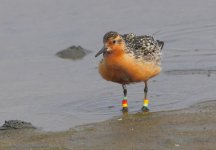I photographed this Knot in Shetland this week with 6 rings on it.
I feel this is way to many and must increase the chances of the bird being caught in fishing Line etc plus the shear discomfort of living its life with so much Bling on its Legs.
I know much useful information is gained from bird ringing but to fit 6 rings on a common species like Knot is it really necessary?
Your views would be appreciated.
Jim Wood
I feel this is way to many and must increase the chances of the bird being caught in fishing Line etc plus the shear discomfort of living its life with so much Bling on its Legs.
I know much useful information is gained from bird ringing but to fit 6 rings on a common species like Knot is it really necessary?
Your views would be appreciated.
Jim Wood





